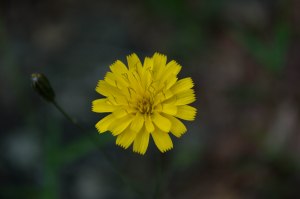Hieracium venosum and Senecio aureus; Asteraceae (aster family)
 In late March or early April the distinctively veined basal leaves of rattlesnake weed start emerging on rocky bluffs and drier soils along the Potomac:
In late March or early April the distinctively veined basal leaves of rattlesnake weed start emerging on rocky bluffs and drier soils along the Potomac:
 A month or so later the long stems start bearing the flowers:
A month or so later the long stems start bearing the flowers:
 You’ll find rattlesnake weed growing alongside azure bluets and plantain-leaved pussytoes.
You’ll find rattlesnake weed growing alongside azure bluets and plantain-leaved pussytoes.
At about the same time, maybe a week earlier, golden ragwort will be in bud:
 Note how the basal leaves and stem leaves are entirely different from each other. Its peak flowering will be well before rattlesnake weed’s.
Note how the basal leaves and stem leaves are entirely different from each other. Its peak flowering will be well before rattlesnake weed’s.
 Golden ragwort likes the wetter soils closer to the river. You can find it on the eastern half of Billy Goat C. Rattlesnake weed will be on the western half, near Carderock.
Golden ragwort likes the wetter soils closer to the river. You can find it on the eastern half of Billy Goat C. Rattlesnake weed will be on the western half, near Carderock.













